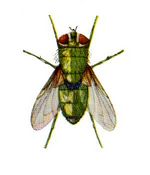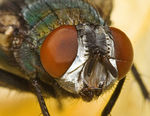Calliphoridae
(Redirected from Bluebottle)
Jump to navigation
Jump to search
- The Calliphoridae family are facultative parasites
- Cause blowfly strike
- If the fly lays eggs on an animal, the animal is said to be blown
- The damage the larvae cause to the animal is known as strike
- Worldwide distribution
- Affects sheep mostly
- Rabbits can also be affected
Species of veterinary importance in Europe
- Lucilia sericata; Greenbottle
- Phormia terra-novae; Blackbottle
- Calliphora erythrocephala; Bluebottle
- Calliphora vomitoria; Bluebottle
Species of veterinary importance in the Tropics
- Lucilia cuprina; South Africa and Australia
- Chrysomya spp.; Africa, Asia and Australia
- Wohlfahrtia; Fleshfly
Recognition of Adults
- Medium sized flies under 10mm long
- Metallic sheen to abdomen
- Colour depends on species
- Clear wings
Recognition of Larvae
- Smooth maggots
- 10-15mm long
- Spiracles and stigmatic plates on the tail can be used for species differentiation
Life cycle
- Eggs laid in wounds, soiled fleece and on carrion
- Females attracted by the odour emitted
- Clusters of yellow-cream eggs laid
- Larvae hatch 24 hours later and crawl down onto the skin
- Feed rapidly
- Grow rapidly
- Moult twice before becoming full maggots
- Process takes 1-2 weeks
- Larvae fall to the ground to pupate
- Adult emerges in under 1 week (during summer)
- The female reaches sexual maturity after a protein meal
- Lays eggs in batches of 100-200
- Adult flies survive for 1 month
- Four generations can develop between May and September
- In warmer climates, up to 9 or 10 generations can develop per year
- Flies can survive the winter as pupae and emerge the next spring


